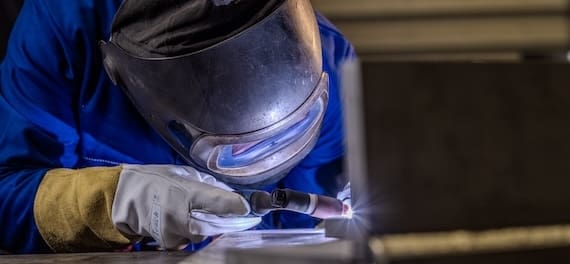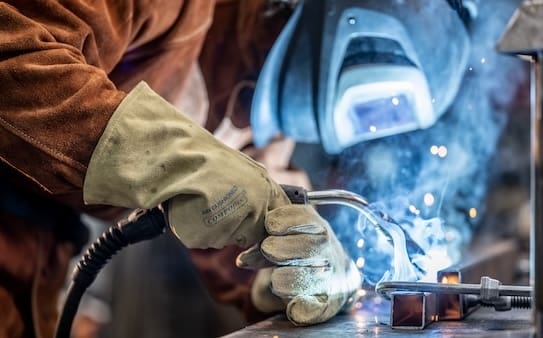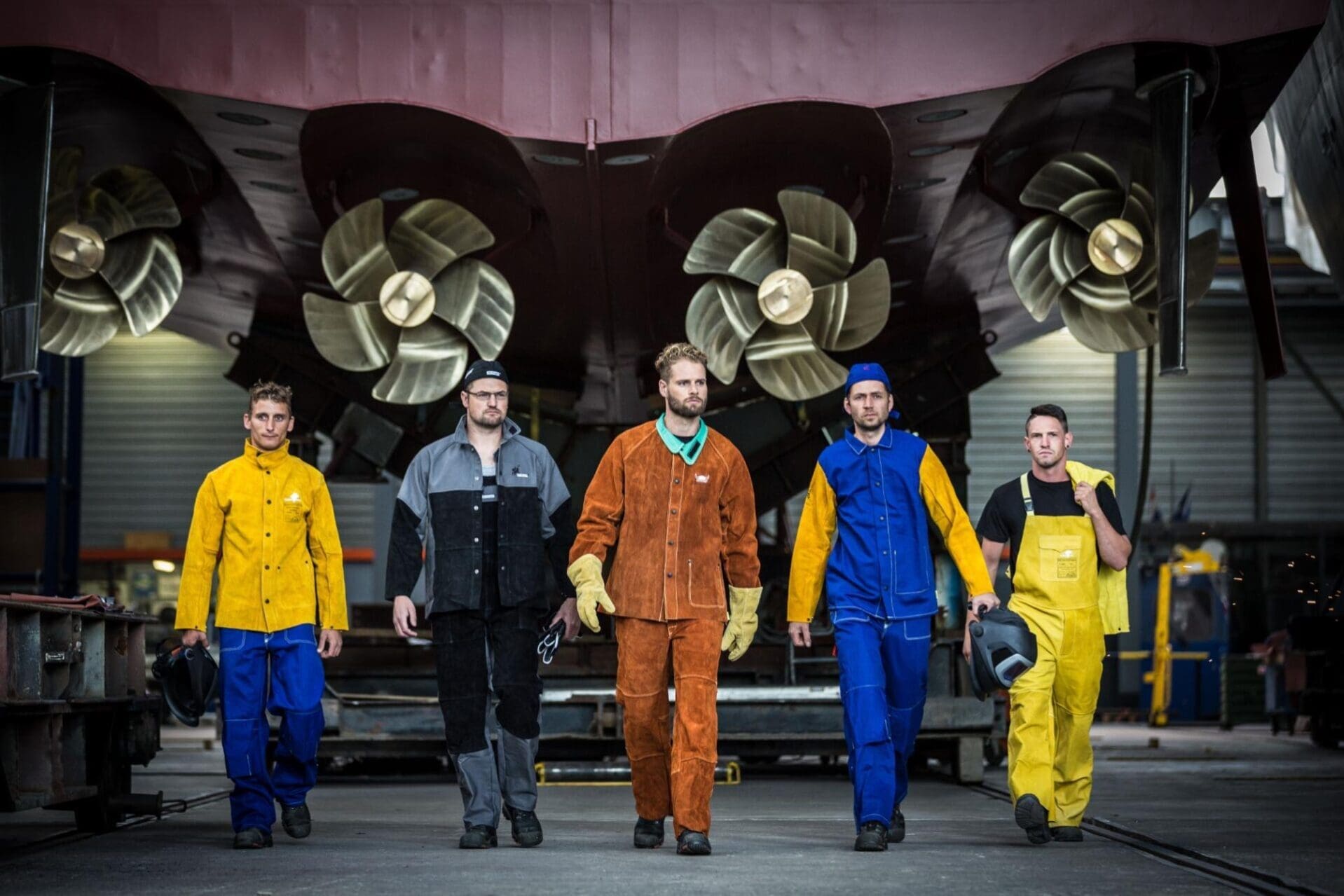
Different types of leather and their application for welding clothing and gloves at Weldas
Weldas is known for its welding clothing and gloves made from high-quality leather. Each type of leather possesses unique properties that make it suitable for specific welding tasks. This article explores the different types of leather, as well as the layers of leather and the impact of different parts of the animal body on the leather quality. From split cowhide to suede pigskin and smooth deerskin, discover which type of leather suits specific products within Weldas’ range.
Terminology of leather layers
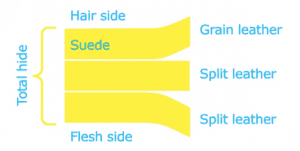
Leather consists of several layers. The hair side of the animal is very smooth and supple, also known as suede or full grain leather. Below this top layer lies a cowhide that varies in thickness. When the hide is thick enough, it can be split into three layers, hence the name split leather.
- The top layer is the best split layer of the hide, also known as grain split or A-grade split leather. The fibre structure here is still very dense and compact, making the leather sturdy with minimal risk of tearing.
- The middle layer is called B-grade or core split. This layer has a more open structure, but is still very firm.
- The bottom layer of the hide is also called flesh split. This layer has a very coarse fibre structure, which increases the risk of damage and tearing.
Types of animal leather
Leather can be sourced from various animals. For leather welding clothing, split cowhide is mainly used, but gloves may incorporate various other leather types. Cowhide is generally more readily available and a cowhide has a larger surface area compared to, for instance, a goat. In addition, goat and deer leather are much more supple, which is advantageous for leather gloves used for welding.
- Split cowhide
Split cowhide is ideal for welding clothing and leather gloves due to its heat and flame resistance. Its open structure makes cowhide breathable, enhancing comfort. Moreover, it is a cost-effective choice. The Lava Brown™ welding clothing is a prime example where A-quality split cowhide has been used for all garments. The split cowhide leather is also featured in work gloves with a leather palm and in several models of the COMFOflex® lined gloves.
- Grain cowhide
Grain cowhide is suitable for welding clothing and gloves because of its flexibility and strength. Water and oil resistance make it ideal for environments with various liquids and splashes. An example of this type of leather is the Golden Brown™ grain leather clothing. Additionally grain cow leather is also used in welding gloves, such as on the backside of the 10-2750 STEERSOtuff® welding glove.
- Suede (reversed) pigskin
Suede pigskin is naturally soft and supple, making it easy to bend. It offers comfort due to its natural breathability, without compromising protection. Pigskin leather has a reasonable level of heat resistance and water repellency, making it suitable for several welding tasks. The 10-1003 SOFTouch™ welding glove is made of suede pigskin, among others.
- Grain deerskin
Grain deerskin is ideal for welding gloves due to its comfortable fit, suppleness and heat insulation. Water and oil resistance contribute to durability. An example where deer leather is used in a glove is the 10-2850 DEERSOsoft® welding glove with COMFOflex® lining.
- Grain goat leather
This lightweight and comfortable leather is perfect for welding gloves where dexterity is essential. Its water and oil resistance increases versatility. The 10-1004 SOFTouch™ glove is made of goatskin leather with a cotton cap. These goat leather gloves offer high finger sensitivity and are also very soft and flexible in use. Additional reinforcements make the glove less likely to wear out.
- Grain bison leather
Grain bison leather offers excellent fit, dexterity and comfort. Its high mechanical value makes it particularly suitable for demanding welding tasks. The 10-2644 SOFTouch™ welding glove made of grain bison leather is ideal for precision welding where extreme finger sensitivity is required.
Leather qualities
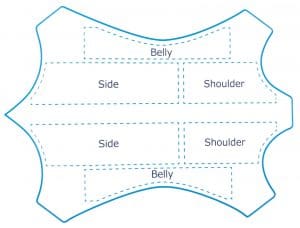
In addition, leather can be sourced from different parts of the animal body. This also affects the leather quality and properties. Additionally, a piece of leather from the shoulder will be more expensive than from the belly. This is because the shoulder is smaller than the amount of leather that can be taken from the belly. Below, we list the different parts of an animal’s hide with its characteristics:
- Leather from the shoulder of the bovine is known for its exceptional suppleness, good strength and flexibility. These properties make it ideal for products where flexibility and comfort are essential, such as welding gloves and clothing.
- Leather from the belly is considered the least quality, but it is the most economical choice. It is suitable for situations where cost-effectiveness is emphasised without compromising too much on durability.
- Side leather, on the other hand, offers the best strength and is characterised by consistent quality. This makes it ideally for high-quality leather products, such as welding clothing, where durability and reliability are of great importance.
Consistent quality thanks to own tannery
At Weldas, we believe that ensuring top quality starts with controlling every aspect of the production process. Our leather products are known for their consistent and excellent quality. By using Wet Blue leather, which is tanned in our own tannery in Cambodia, we can carefully control and perfect the quality of the leather.
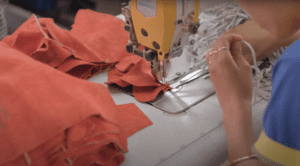
Our craftsmen, with years of experience and expertise, treat the leather in a highly efficient manner, resulting in leather of unparalleled quality. In addition, the leather undergoes another thorough quality control.
At Weldas, we value transparency and traceability. Therefore all our leather welding clothing and welding gloves are equipped with a production label with a unique code. This allows us to trace the entire production process, from the origin of the leather to the tanning process in our factory.
Certification
At Weldas, quality and safety are paramount. The choice of materials and design for welding gloves and welding clothing, as well as for other products in the Weldas range, therefore always depends on the applicable European standard. Therefore our products are tested and certified by a testing and certification laboratory. View all reports and certificates on our dedicated CE website. If you have questions about the leather used or which type of leather is best for your welding tasks, please don’t hesitate to contact us; we’re happy to help.

